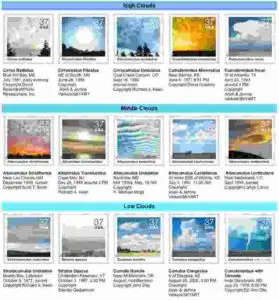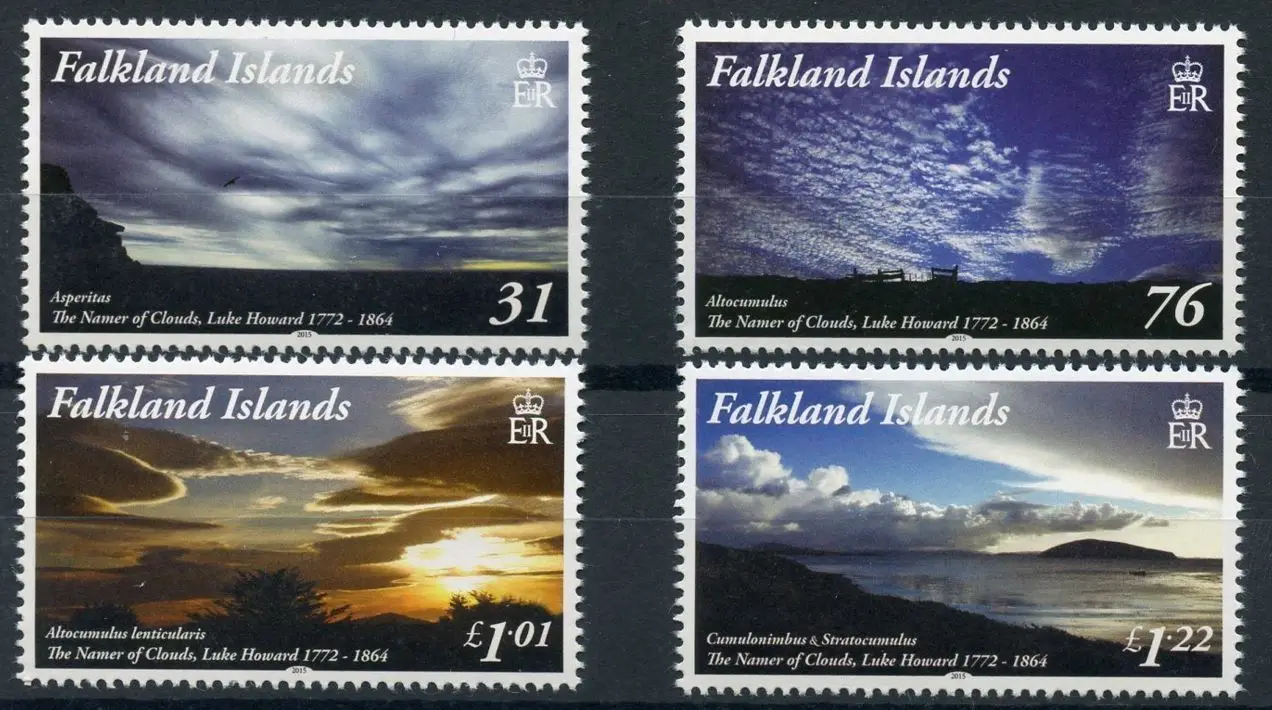This video describes the types of clouds.
Starting at 2m 37s Oliver Crewdson Howard talks about Luke Howard
How did clouds get their names? – by Richard Hamblyn.
“The study of clouds has always been a daydreamer’s science, aptly founded by a thoughtful young man whose favorite activity was staring out of the window at the sky. Richard Hamblyn tells the history of Luke Howard, the man who classified the clouds and forever changed humanity’s understanding of these changeable, mysterious objects.”
US stamps issued in October 2004
source: University of British Columbia:
Nine of the ten basic cloud genera are pictured on this stamp pane and arranged according to altitude. The prefixes “cirro” and “alto” distinguish high- and middle-altitude clouds, respectively. Nimbostratus, a dark featureless cloud, is marked by falling rain or snow. As the Nimbostratus lacks defined shape, a reproduction of its image through a stamp would appear to be meaningless visually.
In the early 19th century, Englishman Luke Howard – chemist by trade and meteorologist by avocation – created a system for classifying clouds using Latin names. He described the three most common shapes as cirrus (curl of hair), stratus (layer) and cumulus (heap); he also defined four compound cloud forms that derive from the three primary shapes, including nimbus (rain). Later scientists added terms such as humilis (small) and incus (anvil) to designate other cloud properties. The International Cloud-Atlas, first published in 1896, is based on this classification system.
Cloud descriptions printed on the back of the stamp pane
Composed of windblown ice crystals, cirrus are fibrous, often wispy clouds that appear in isolated patches or cover large areas of the sky. Cirrus radiatus appear to emerge from the horizon in parallel bands.
Relatively transparent cirrostratus fibratus clouds occur mostly in winter and often produce a halo effect around the sun or moon. Thickening cirrostratus frequently indicate the approach of a frontal system.
Cirrocumulus undulatus are patches or layers of small puffy clouds arranged in patterns. They have a rippled appearance due to wind shear and usually cover only a small portion of the sky.
Pouch-like cumulonimbus mammatus develop when pockets of air chilled by evaporating droplets or ice crystals sink into dry surroundings under the anvil. They usually indicate the approach or departure of a potentially severe thunderstorm.
Cumulonimbus incus, or thunderstorm clouds, form when rapid updrafts within cumulus congestus clouds rise into the upper atmosphere and spread out into mushroom-shaped anvils. Thunderstorms always produce lightning; severe storms may produce heavy rain, large hailstones, or tornadoes.
Small heaps arranged in layers or sheets, altocumulus stratiformis clouds are primarily composed of water droplets and, as depicted here, reflect glorious colors at sunset. If they become thicker during the day, a storm may be approaching.
Altostratus translucidus, cloud sheets formed by the rising and cooling of large air masses, often precede advancing storm systems. A “watery” sun (or moon) may shine dimly through the thinner sections of the cloud sheet.
Resembling ripples on water, altocumulus undulatus clouds result from wind shear – wind speed and direction that changes sharply with height. They may appear as patches or cover the sky.
Named for the turret-like protuberances in their top portions, altocumulus castellanus clouds signify unstable air in the vicinity and often indicate the potential for thunderstorms later in the day.
Smooth, almost motionless altocumulus lenticularis clouds resemble lenses and may be iridescent. They often look like UFOs and form in the crests of waves that occur when strong winds cross over a mountain peak or ridge.
Stratocumulus undulatus occur when weak updrafts spread horizontally, creating a layer of shallow, puffy clouds that is blown by strong winds into wave-like formations that lie at right angles to the wind. These clouds seldom produce precipitation.
Gray, featureless cloud layers that can spread over hundreds of square miles, stratus opacus, like stratocumulus, are generally composed of water droplets. Stratus clouds occasionally produce drizzle or light snow.
Cumulus humilis – the smallest of the cumulus clouds – have flat bases and rounded tops. Usually wider than they are tall, these fair-weather clouds very rarely produce precipitation and often evaporate as the sun sets.
Strong, buoyant updrafts of warm, moist air in an unstable atmosphere cause cumulus clouds to develop into cumulus congestus. These towering clouds can produce moderate rain or snow showers and may grow into cumulonimbus clouds.
Among nature’s most destructive phenomena, tornadoes are rapidly spinning columns of rising air extending between the base of a cumulonimbus cloud and the ground. In extreme cases, tornado winds may exceed 250 miles and hour.
Falkland Island Stamps
source: Falklands Post Service
Clouds are a major feature of Falkland Islands weather. Influenced by the predominantly westerly winds which arise on the South American Continent together with the effects of the Andes, cloud forms are varied and extensive. Clouds are further modified by the Island terrain to form “mountain modifications” which develop from the higher elevations, “Roll cloud” at low levels, particularly in northerly winds forming behind the Wickham Heights and Cumulonimbus which generally form in southerly winds.
In this four stamp issue three of the more common cloud forms to be seen in the Falkland Islands are depicted: Altocumulus on the 76p value, Altocumulus lenticularis on the £1.01 value and Cumulonimbus and Stratocumulus on the £1.22 value.
The 31p value shows a rare form of cloud called asperitas (latin for “roughness”). Cloud watchers have been reporting these oddly shaped clouds for several years and due to the efforts of the Cloud Appreciation Society over many years it is expected that this new cloud type will finally be getting official recognition. This year the World Meteorological Organization (WMO) proposed a definition for the clouds. “A formation made up of well-defined, wavelike structures in the underside of the cloud, more chaotic and with less horizontal organization than undulatus. It is characterised by localized waves in the cloud base, either smooth or dappled with smaller features, sometimes descending into sharp points, as if viewing a roughened sea surface from below. Varying levels of illumination and thickness of cloud can lead to dramatic visual effects”.
It is hoped that the WMO will include asperitas in its revised 2016 International Cloud Atlas making it the first new cloud type identified since 1951. The inclusion of this rare cloud in this issue from the Falkland Islands is therefore both significant and timely.

